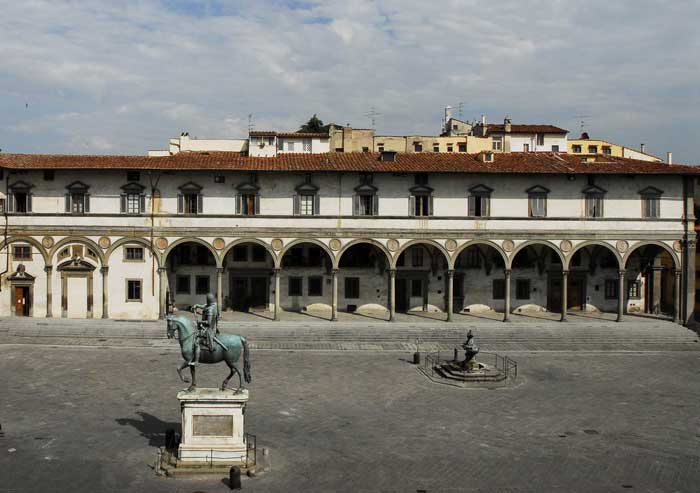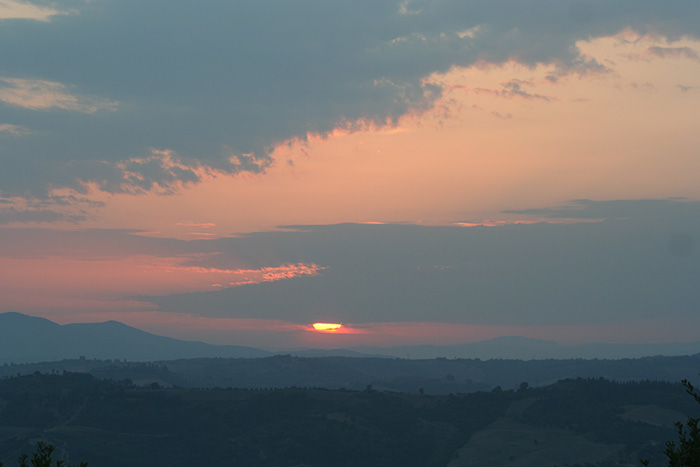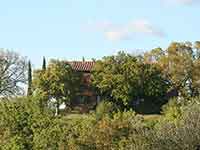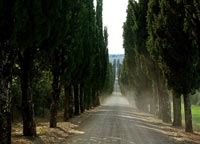| To this day, the squares characterize the appearance of Florence. From a historical perspective, their development was linked to various factors. The Piazza and Palazzo della Signoria became a centre of political authority to counterbalance the ecclesiastic power at the cathedral. Smaller squares emerged in front of the main churches and at road junctions. The large forecourts of the converts that settled outside the second city wall brought a new type of square along during the formidable rise of the mendicant orders in the 13th century – they all formed spaces of religious, social, economic and cultural life from this point on. During the Renaissance, the targeted structuring of urban space became a central focus of architecture: The most famous example of this is the Piazza della Santissima Annunziata with Brunelleschi’s portico. This and other Florentine squares were common motifs in print reproductions. In character, some of the views shown here go back to the series of etchings from Giuseppe Zocchi’s “Scelta di XXIV Vedute”, which appeared in 1744 and enjoyed huge success. One example of this is the (nevertheless laterally transposed) reproduction of San Pier Maggiore, which represents an important historical document at the same time: In 1783, the church was demolished with the exception of the three arches of the portico; the Via San Pier Maggiore today runs through the former nave.[0]
The Piazzale Michelangelo, dedicated to the great Renaissance sculptor Michelangelo, overlooks one of the most famous and magnificent city views in the world. From here you can see the whole of Florence at a glance – from Forte Belvedere to Santa Croce, the Ponte Vecchio, the Duomo, the Uffizi, Palazzo della Signoria and the Bargello, etc. Higher up, on the other side of Florence, you can see the hills to the north, with Fiesole and the tall belltower of its Cathedral (1213) standing out in their midst.
Built on the ruins of the 13th century Ghibelline homes, Piazza della Signoria has been the center of the political and social life of the city for centuries and is without doubt the most beautiful square in Florence. Piazza della Signoria is the focal point of the origin and of the history of the Florentine Republic and still maintains its reputation as the political hub of the city. The impressive 14th century Palazzo Vecchio is still preeminent with its crenellated tower. The square is also shared with the Loggia della Signoria, the Uffizi Gallery, the Palace of the Tribunale della Mercanzia (now the Bureau of Agriculture), and the Uguccioni Palace (16th century, with a facade by Raphael). Located in front of the Palazzo Vecchio is the Palace of the Assicurazioni Generali.
Piazza del Duomo is located in the heart of the historic centre of Florence. Is one of the most visited place in the Europe and the world; here we can find the Florence Cathedral with the Cupola del Brunelleschi, the Giotto's Campanile, the Florence Baptistry, the Loggia del Bigallo, the Museo dell'Opera del Duomo, and the Arcivescovile and Canonici's palace. The west zone of this square is called San Giovanni square.
Piazza della Repubblica is a square in the centre of Florence, location of the cultural cafes and bourgeois palaces. Among the square's cafes, the Giubbe Rosse cafe has long been a meeting place for famous artists and writers, notably those of Futurism.
Piazza Santa Croce is dominated by the Basilica of Santa Croce it is a rectangular square in the center of the city. Here the Calcio Fiorentino is played every year and when can find on this square the Palazzo dell'Antella, the Palazzo Cocchi-Serristori (main office of center of Florence quarter) and the Dante's statue.
Piazza San Lorenzo offers the great Basilica of San Lorenzo with the Cappelle Medicee, a lively open market and the Laurentian Library.
Piazza Santa Maria Novella is one of the principal squares of Florence with the Basilica of Santa Maria Novella and the Alinari phography museum. It is opposite of piazza della Stazione, andaccessible by the Via degli Avelli.
Piazza della Santissima Annunziata is located near piazza San Marco and piazza del Duomo is an harmonious square which overlooks the Ospedale degli Innocenti, the Loggia dei Servi di Maria, the Budini Gattai palace and the National Archaeological Museum
Piazza della Stazione: It is a big square in the center of the city, one of the main focal point of transport in Florence. Here converge almost the entire bus-line, and tramways, and the central station of Florence the biggest and masterpiece of Rationalism Firenze Santa Maria Novella railway station, that is used by 59,000,000 people every year [1]. On piazza della Stazione we can also find the Palazzina Reale di Santa Maria Novella (where the king of Italy stayed), and the Palazzo degli Affari.
Piazza dell'Indipendenza is a wide square located near piazza della Stazione and San Lorenzo market, with palaces typically bourgeois where lived Guido Nobili and Theodosia Gorrow Trollope wife of the writer Anthony Trollope.
Piazza San Marco is located in the north zone of the historic centre of Florence near the Piazza della Santissima Annunziata, it hosts the Basilica of San Marco, the headquarters of the University of Florence and the renowned Academy of Fine Arts of Florence.
Piazza Santa Trinita is a square near the Arno that mark the end of the elegant fashion-street of Via de' Tornabuoni. On the Piazza Santa Trinita overlook the Basilica of Santa Trinita (that gives the name to the square), the Palazzo Spini Feroni, the Palazzo Boundelmonti, the Palazzo Bartolini Salimbeni and the Column of Justice.
Piazza dei Ciompi hosts the Loggia del Pesce made by Giorgio Vasari and the house of Lorenzo Ghiberti.
The Piazza d'Azeglio, near the Viali di Circonvallazione, shows of the Villino Uzielli Palace.
The Piazza Goldoni is located in front of Ponte alla Carraia. The Palazzo Ricasoli and the statue dedicated to Carlo Goldoni are the main sights.
|
![]()
![]()
![]()
![]()
![]()










